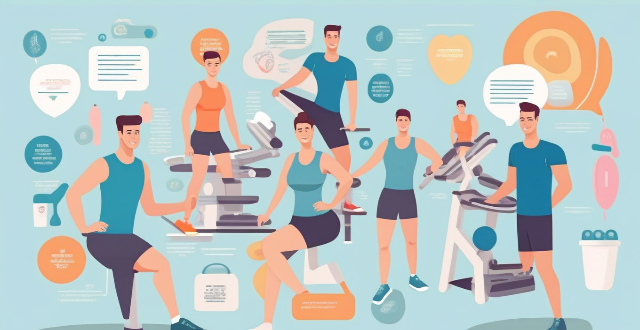Weight Fitness

Can fitness trackers help me achieve my weight loss goals ?
Fitness trackers can support weight loss by tracking steps, heart rate, sleep, and calories. They provide motivation, accountability, and data for decision making. However, they have limitations such as overreliance on technology and accuracy concerns. It's important to use them wisely and in conjunction with other healthy habits for effective weight loss.

How much weight should I lift during strength training ?
The amount of weight you should lift during strength training depends on various factors such as your fitness level, goals, and experience. Here are some guidelines to help you determine the appropriate weight for your routine: start with a light weight, increase gradually, choose the right number of repetitions, listen to your body, and consider your goals. Remember to consult with a fitness professional or personal trainer to develop a customized program that meets your specific needs and goals.

What's wrong with the belief that cardio is the best way to lose weight ?
This critical analysis challenges the prevailing belief that cardio exercises are the most effective way to lose weight. It argues that this belief is misguided due to an overemphasis on calorie burning, neglect of other forms of exercise, potential for overuse injuries, and limited sustainability and enjoyment. The analysis suggests a well-rounded fitness routine that includes strength training, flexibility exercises, and other forms of physical activity to support overall health, prevent injuries, and ensure long-term success in maintaining a healthy weight.

How does the misunderstanding of calories in vs. calories out impact fitness goals ?
The misunderstanding of the concept of calories in vs. calories out can significantly impact fitness goals, leading to difficulty in achieving weight loss, muscle loss, and a slower metabolism. It is important to incorporate both a healthy diet and regular physical activity to ensure that more calories are burned than consumed.

Can aerobic exercise help me lose weight ?
Aerobic exercise, or cardio, is an effective way to lose weight. It increases heart rate and breathing, leading to higher calorie burn during and after the workout. Moderate-intensity aerobic activities also use fat as fuel, improving metabolic rate for further calorie expenditure at rest. Regular cardio can strengthen heart muscles for efficient blood pumping and contribute to muscle endurance. Types of aerobic exercises include running, cycling, swimming, walking, and group fitness classes like Zumba. To successfully incorporate aerobic exercise into a weight loss plan, it's recommended to start slowly, mix up activities, stay consistent, and combine with strength training. Potential challenges such as overexertion and plateaus in progress should be managed by adjusting routines. Overall, aerobic exercise can aid in weight loss when part of a balanced fitness regimen.

What are the best exercises for weight loss ?
Losing weight requires a combination of a healthy diet and regular exercise. The best exercises for weight loss include cardiovascular exercises like running, cycling, swimming, and jumping rope; strength training exercises like squats, lunges, push-ups, and planks; and high-intensity interval training (HIIT) workouts like Tabata, burpees, and mountain climbers. By incorporating these exercises into your routine, you can burn calories, build muscle, and improve your overall fitness level.

Can strength training help with weight loss ?
Strength training, involving the use of resistance to induce muscular contraction and build strength, can significantly contribute to weight loss by increasing metabolic rate, boosting post-exercise oxygen consumption (EPOC), improving body composition, and enhancing appetite control. Incorporating strength training into your routine, starting slowly and focusing on compound movements while staying consistent, can help achieve weight loss goals.

Can running help me lose weight quickly ?
Running is a popular form of exercise that can help you lose weight quickly, but it's important to understand the factors that contribute to weight loss and how running fits into the equation. In this response, we'll explore the benefits of running for weight loss and provide tips on how to maximize your results. Benefits of Running for Weight Loss: 1. Burns Calories: Running is a high-intensity cardio workout that burns a significant number of calories per minute. The more calories you burn during exercise, the easier it is to create a calorie deficit, which is necessary for weight loss. 2. Increases Metabolism: Running can boost your metabolism, allowing you to burn more calories even when you're not exercising. This increased metabolic rate can lead to faster weight loss over time. 3. Builds Muscle: Running helps build lean muscle mass in your legs, glutes, and core. Muscle tissue burns more calories at rest than fat tissue, so having more muscle can contribute to faster weight loss. Tips for Maximizing Weight Loss with Running: 1. Set Realistic Goals: Aim for a healthy rate of weight loss, such as 1-2 pounds per week. Rapid weight loss can be harmful and difficult to maintain in the long term. 2. Combine Cardio and Strength Training: Incorporate strength training exercises into your routine to build muscle and increase your overall calorie burn. Focus on compound movements like squats, lunges, and deadlifts to target multiple muscle groups at once. 3. Stay Consistent: Make running a regular part of your routine, aiming for at least 3-4 sessions per week. Consistency is key to achieving long-term weight loss goals. 4. Watch Your Diet: Pay attention to what you eat and try to consume a balanced diet rich in whole foods, lean proteins, and healthy fats. Avoid processed foods, sugary drinks, and excessive amounts of alcohol, which can hinder weight loss efforts. 5. Rest and Recovery: Allow your body time to rest and recover between running sessions to prevent injury and avoid burnout. Incorporate stretching and foam rolling into your routine to aid recovery and improve flexibility. Conclusion: While running can be an effective way to lose weight quickly, it's important to approach your fitness journey with patience and realistic expectations. By combining running with strength training, watching your diet, and staying consistent with your workouts, you can maximize your weight loss results and achieve a healthier lifestyle.

How do fitness trackers measure calories burned ?
**How Fitness Trackers Measure Calories Burned: A Comprehensive Overview** Fitness trackers have revolutionized the way we monitor our physical activities and health. One of their most popular features is the ability to estimate the number of calories burned during various exercises. But how do these devices actually calculate this information? In this article, we delve into the science behind fitness trackers and explore the key components that contribute to their calorie-burning estimates. Firstly, heart rate monitoring plays a crucial role. By tracking your heart rate, fitness trackers can gauge the intensity of your workout and, therefore, the approximate number of calories you're burning. Secondly, activity recognition allows the device to identify specific types of movement, such as walking or running, and apply corresponding metabolic equivalent (MET) values to calculate energy expenditure. Thirdly, personal information like age, gender, height, weight, and daily activity level are essential for customizing calorie burn calculations to your unique profile. Finally, sophisticated algorithms combine all these data points to provide an estimate of calories burned. However, it's important to remember that these estimates are not exact measurements but rather approximations based on scientific research and technological advancements. As such, fitness trackers should be viewed as valuable tools to aid in your fitness journey rather than definitive indicators of progress.

How can I create a fitness plan specifically for women ?
Creating a fitness plan for women involves understanding their unique physical and physiological needs. Tips include setting realistic goals, incorporating strength training and cardiovascular exercises, considering hormonal cycles, staying hydrated and fueling the body properly, and seeking professional guidance when needed. By following these tips, women can achieve their fitness goals and improve their overall health and well-being.

What kind of diet is recommended for women who want to lose weight through exercise ?
Recommended diet for women who want to lose weight through exercise includes lean protein, complex carbohydrates, healthy fats, and plenty of water. It's important to eat a light meal or snack before workouts and refuel with protein and carbohydrates after exercising. Portion control and avoiding empty calories are also crucial for weight loss success.

How do I choose the right sports equipment for my fitness level ?
When selecting sports equipment, consider your fitness level to avoid injury and maximize workouts. Assess your fitness level (beginner, intermediate, advanced), identify goals (strength training, cardiovascular health, flexibility/balance), and prioritize ease of use, comfort, safety, budget, research, trial before purchase, and space considerations for effective and safe exercise.

How can I create a balanced fitness meal plan ?
To create a balanced fitness meal plan, start by determining your caloric needs and focus on nutrient-dense foods. Include lean protein, whole grains, fruits, vegetables, and healthy fats in your meals. Balance your macronutrients (carbs, protein, and fats) and plan your meals and snacks ahead of time to ensure you're getting the right balance of nutrients throughout the day. Stay hydrated and be mindful of portion sizes to support your health and fitness goals.

Can strength training be part of a female fitness program ?
**Can Strength Training Be Part of a Female Fitness Program?** Yes, strength training is crucial for women's fitness programs. It offers benefits such as improved muscle tone, increased metabolism, enhanced bone density, and reduced injury risk. To integrate strength training effectively: start with light weights, focus on compound movements, balance it with cardio workouts, and consider professional guidance for personalized plans. This approach ensures a comprehensive and beneficial fitness regimen for women.

What are some common mistakes people make when creating a fitness meal plan ?
When creating a fitness meal plan, it's important to avoid common mistakes such as neglecting macronutrient distribution, ignoring micronutrient needs, underestimating calorie needs, overcomplicating meal preparation, and neglecting hydration. To ensure success in achieving health and fitness goals, prioritize balance, simplicity, and sustainability while focusing on meeting individual nutritional needs.

How much weight can I expect to lose by exercising regularly ?
The amount of weight you can expect to lose through exercise depends on several factors, including your current weight, body composition, and the type and intensity of exercise you perform. High-intensity interval training (HIIT) and strength training are generally more effective for weight loss than low-impact activities like yoga or walking. In the short term, you may experience significant weight loss due to water loss and increased muscle tone, but for long-term weight loss, regular exercise combined with a healthy diet is essential. To maximize your weight loss potential through exercise, incorporate strength training, vary your workouts, increase intensity gradually, and stay consistent.

How can I create a sustainable fitness routine for better health ?
Creating a sustainable fitness routine is crucial for maintaining good health and achieving long-term fitness goals. Here are some tips on how to create a sustainable fitness routine: ## 1\. Set Realistic Goals * **Start Small:** Begin with small, achievable goals that you can gradually build upon. This will help you avoid burnout and stay motivated. * **Be Specific:** Clearly define your fitness goals, such as losing weight, gaining muscle, or improving cardiovascular health. ## 2\. Choose an Activity You Enjoy * **Find Your Passion:** Select an exercise that you genuinely enjoy, whether it's running, swimming, cycling, or dancing. This will make it easier to stick to your routine. * **Mix It Up:** Incorporate variety into your workouts by trying different activities or switching up your routine regularly. ## 3\. Make It Part of Your Daily Routine * **Schedule It In:** Treat your workouts as non-negotiable appointments in your calendar. Plan them around your work and personal life commitments. * **Create a Habit:** Aim to exercise at the same time each day to establish a consistent habit. ## 4\. Track Your Progress * **Keep a Journal:** Record your workouts, including the type of exercise, duration, and intensity. This will help you monitor your progress and adjust your routine accordingly. * **Set Milestones:** Celebrate small milestones along the way to stay motivated and focused on your long-term goals. ## 5\. Stay Accountable * **Find a Workout Buddy:** Having a friend or family member to exercise with can provide motivation and accountability. * **Join a Group Class:** Enrolling in group fitness classes can also offer social support and encouragement from others working towards similar goals. ## 6\. Listen to Your Body * **Rest and Recovery:** Allow adequate rest days between workouts to prevent injury and promote recovery. * **Adjust Intensity:** Pay attention to how your body feels during and after exercise. If you're feeling excessively fatigued or experiencing pain, consider reducing the intensity or duration of your workouts. By following these tips, you can create a sustainable fitness routine that supports better health and long-term success. Remember to be patient with yourself and celebrate every step towards achieving your fitness goals!

Can organic food help with weight loss ?
Organic food may aid weight loss by reducing exposure to harmful chemicals, offering higher nutrient content, having lower calorie density, and improving digestion. Incorporating organic options slowly, choosing locally grown produce, reading labels carefully, planning meals, and including protein sources can support a healthy eating plan conducive to weight loss.

What features should be included in a comprehensive sports and fitness app ?
A comprehensive sports and fitness app should provide a broad range of features to cater to the diverse needs of its users, including goal tracking, workout planning, nutrition tracking, social interaction, personalized coaching, and health monitoring. These features are designed to help users achieve their fitness goals, track progress, and stay motivated throughout their journey.

What are the best fitness apps for tracking workouts and monitoring progress ?
The text discusses the best fitness apps for tracking workouts and monitoring progress, including: 1. **MyFitnessPal** - Calorie tracker with goal setting and community support. 2. **Strava** - GPS tracking for outdoor workouts with leaderboards and route planning. 3. **Nike Training Club** - Offers workout plans with video tutorials and a variety of exercises. 4. **Fitbit** - Activity tracker syncing data from Fitbit devices with goal setting and food logging. 5. **7 Minute Workout** - Quick high-intensity workouts that can be done without equipment. 6. **Couch to 5K (C25K)** - Beginner-friendly app for starting a running routine with motivational coaches. 7. **Yoga Studio** - Wide variety of yoga classes with customizable and audio options. 8. **Sworkit** - Customizable bodyweight exercise routines with a variety of workouts. 9. **Freeletics** - AI coaching for personalized workout plans and nutrition guidance. 10. **Adidas Runtastic** - GPS tracking with training plans and health metrics.

Are fitness trackers worth the investment ?
Fitness trackers can provide motivation, data collection, convenience, community support, and customization. However, they also come with potential drawbacks such as cost, inaccuracy, dependency, overemphasis on quantification, and battery life issues. The decision to invest in a fitness tracker should be based on individual needs and priorities.

What certifications should I get as a fitness instructor ?
To become a certified fitness instructor, it's crucial to obtain essential certifications like CPR/AED, personal training, group fitness instruction, and specialty areas of interest. Participating in continuing education will help you stay current and relevant in your field.

How do I choose the right fitness tracker for my needs ?
When selecting a fitness tracker, consider your goalsWhen selecting a fitness tracker, consider your goals, device compatibility, consider your goals, budget, tracking features, device compatibility, design, and reviews. Test the tracker before buying if possible to ensure it meets your needs and helps you achieve your fitness goals.

Can family members of different ages and fitness levels do the same home workout ?
The question of whether family members of different ages and fitness levels can engage in the same home workout is a pertinent one, especially considering the numerous health benefits associated with regular exercise. The positive effects of physical activity on longevity and disease prevention are well-documented At the core of this inquiry lies the understanding that exercise, regardless of its form, be it running or weight lifting, significantly contributes to a longer and healthier life. Given the myriad benefits of regular physical activity, families are often inclined to incorporate workout routines into their daily lives. However, the variance in age and fitness levels among family members presents certain challenges and considerations:

Are there any free sports and fitness apps that offer accurate calorie counting and meal planning ?
The text discusses free sports and fitness apps that offer accurate calorie counting and meal planning. It suggests four different apps: MyFitnessPal, Lose It!, Fitbit, and Nike Training Club. Each app is described in terms of its features, including calorie counting, meal planning, and exercise tracking. The text concludes by stating that these apps can help users track their progress and stay motivated towards achieving their fitness goals.

How can health management apps be used to support weight loss goals and promote healthy habits ?
The text discusses the role of health management apps in supporting weight loss goals and promoting healthy habits. It highlights three key features: tracking progress, making informed decisions, and developing healthy habits. The apps offer real-time data on calorie intake, exercise activity, body measurements, and provide information about diet and exercise routines. They also promote healthy habits beyond weight loss, such as drinking water, taking breaks from sitting, meditation, and sleep tracking. Overall, these apps provide users with tools to achieve their desired outcomes and maintain a balanced lifestyle.

What are some common mistakes that women make when starting a new fitness plan ?
Starting a new fitness plan can be exciting and daunting at the same time. However, many women make some common mistakes that can hinder their progress and lead to frustration. Here are some of the most common mistakes: 1\. Setting Unrealistic Goals: One of the biggest mistakes women make when starting a new fitness plan is setting unrealistic goals. It's important to set achievable and realistic goals that align with your fitness level, lifestyle, and schedule. 2\. Overtraining: Another common mistake is overtraining. This can lead to fatigue, burnout, and even injury. It's essential to listen to your body and give it enough rest and recovery time between workouts. 3\. Neglecting Nutrition: Many women focus solely on exercise and neglect their nutrition. However, what you eat plays a crucial role in achieving your fitness goals. A balanced diet with adequate protein, healthy fats, and complex carbohydrates is essential for fueling your workouts and promoting muscle growth and recovery. 4\. Not Warming Up or Cooling Down: Skipping warm-up or cool-down exercises can increase the risk of injury and reduce the effectiveness of your workouts. A proper warm-up prepares your body for exercise by increasing blood flow and warming up your muscles, while a cool-down helps your body gradually return to its resting state. 5\. Relying Solely on Cardio: While cardio is an excellent way to burn calories and improve cardiovascular health, relying solely on it can lead to a plateau in weight loss and muscle tone. Incorporating strength training into your fitness plan can help build lean muscle mass, which boosts metabolism and leads to more efficient calorie burning. 6\. Ignoring Pain or Discomfort: Many women push through pain or discomfort during their workouts, thinking it's just part of the process. However, ignoring pain or discomfort can lead to serious injuries that set back your progress significantly. If something doesn't feel right, it's essential to stop and seek professional advice. 7\. Comparing Yourself to Others: Comparing yourself to others can be discouraging and demotivating. Everyone has different bodies, fitness levels, and goals, so it's essential to focus on your own progress rather than comparing yourself to others. Remember that everyone starts somewhere, and consistency and dedication are key to achieving your fitness goals.

Can yoga help with weight loss ?
Yoga can be a valuable addition to a weight loss program due to its ability to improve muscle tone, increase flexibility, reduce stress levels, and promote mindful eating habits. Incorporating yoga into your routine along with other forms of exercise and healthy lifestyle habits can help you achieve your weight loss goals and improve overall health and well-being.